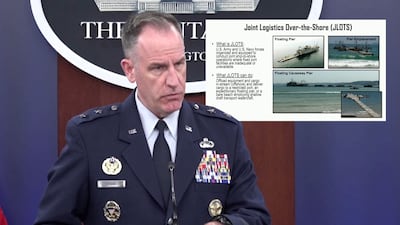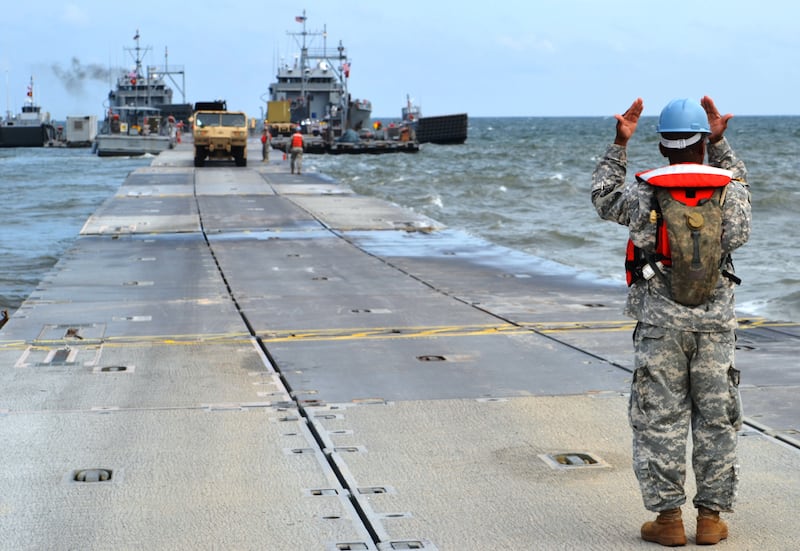Live updates: Follow the latest on Israel-Gaza
A fire onboard a US army ship heading to Gaza has raised doubts over whether the tight deadline for the complex mission of building a floating pier for aid deliveries can be met.
On Tuesday evening it was reported the USNS 2nd Lt. John P. Bobo vessel, which was part of the floating pier operation, had to return to shore after a fire broke out in its engine room last Wednesday.
There were no casualties but the incident has highlighted concerns that the vital aid pier project could stall as hundreds of thousands of Gazans face hunger and malnutrition.
President Joe Biden announced last month that the US would send an army task force, led by Military Sealift Command, to build a floating pier to help unload aid deliveries to Gaza, a construction operation involving five highly specialised vessels that would take about 60 days.

The Pentagon on Tuesday said this deadline had not changed, despite losing one of the ships from the initial task force of five.
Another vessel, the MV Roy P. Benavidez, later joined the task force, carrying heavy machinery to assist in building the pier, a structure known as a Trident that can be more than 500 metres long and carry cargo lorries to the shore.
Gaza’s small fishing port is damaged and lacks the capacity and depth to handle the millions of tonnes of aid needed in the short-term to alleviate a humanitarian emergency – and in the long-term to rebuild.
Cyprus aid corridor risk
World Central Kitchen, a US-based charity struck by tragedy after seven staff were killed in an Israeli air strike last month, has already built a temporary pier from rubble to move aid to the shore, up to a couple of hundred tonnes per shipment arriving from a distribution centre in Cyprus.
The deadly Israeli strike led to a suspension of that effort, and several other NGOs followed, fearing their staff would not be safe working in the strip. WCK said in a statement on an initial Israel report, into the attack, that their staff had "followed all proper communications procedures," with Israeli forces.
WCK were a key part of a joint operation, the Amalthea Initiative, involving Germany, Greece, Italy, the Netherlands, Cyprus, the UAE and UK.
The ship fire also highlights concerns that the US army’s maritime logistics capacity is outdated and lacks the budget for vessel maintenance, potentially putting the rest of the aid pier mission at risk.
The National highlighted the maintenance issue early last month in an interview with Salvatore Mercogliano, a maritime historian at Campbell University, North Carolina, who has worked with the US Department of Defence.
Mr Mercogliano said the army had cut budgets for its 'Joint Logistics Over the Shore' (JLOTS) maritime programme. He said the US was at risk of losing the D-Day-like capability to build an offshore port, as the allies did to move supplies in the 1944 liberation of Europe.
“JLOTS has high visibility in the armed forces but little outside,” Mr Mercogliano told The National. "It had a major role in the Second World War and Vietnam, and a lesser one in Iraq in 2003."
If successful, the Gaza aid pier mission could spur the US to “purchase newer watercraft and overhaul the system”, he said.
It remains to be seen how much of a loss the USNS John P Bobo will be. According to analysis by the New America think tank, the US Army watercraft fleet has suffered low “readiness” for missions with less than 40 per cent of ships being available at a given time.
Two US Army logistics ships, USNS Bob Hope and USNS Fisher could potentially serve as back-up vessels if further problems are encountered, having taken part in a JLOTS exercise last year.
In the meantime, the MV Roy P. Benavidez and USNS 1st Lt. Baldomero Lopez have joined the task force, restoring it to five ships.
Mr Mercogliano, who also hosts the What’s Going on With Shipping programme on YouTube, on Thursday noted the first ship to be deployed, the USS General Frank S. Besson, appears to have suffered an unexplained delay in the Azores.
The Bobo has been in service for 39 years, well beyond the average service life of such a vessel, Mr Mercogliano highlighted.






